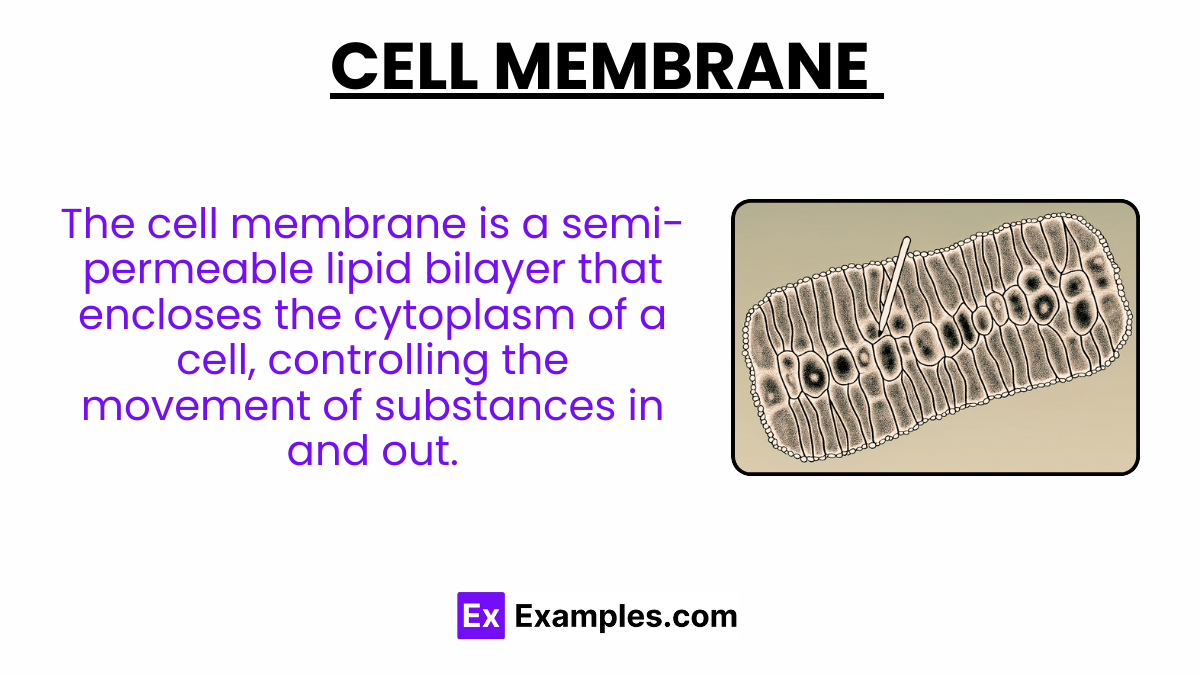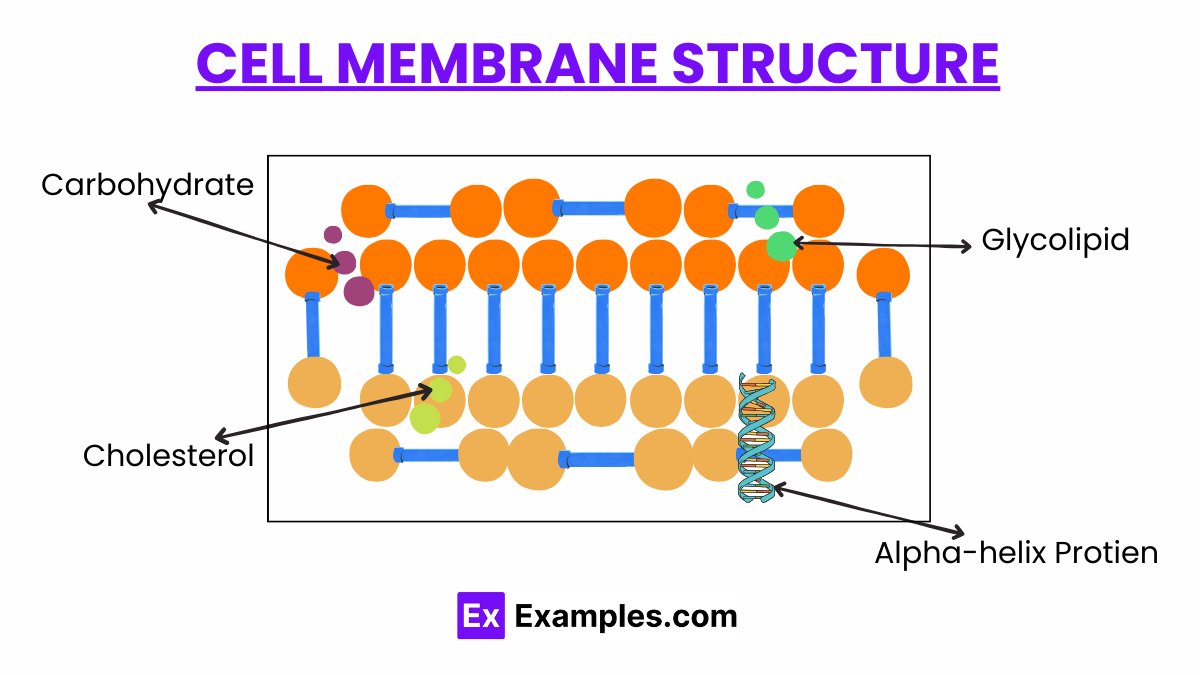What is the primary function of the cell membrane?
To store genetic information
To regulate the movement of substances in and out of the cell
To produce energy
To provide structural support for the cell


Dive into the fascinating world of the cell membrane, the thin, protective barrier that encases every cell, orchestrating a symphony of life-sustaining activities. This comprehensive guide explores the cell membrane’s structure, functions, and the critical role it plays in maintaining cellular integrity, communication, and nutrient transport. Through real-life examples, uncover how this dynamic boundary facilitates selective permeability, signal transduction, and energy transduction, making it essential for survival and function in diverse biological contexts.
Cell membranes, also known as plasma membranes, are fundamental components of all living cells, acting as the critical barrier that separates the interior of the cell from its external environment. This dynamic structure is not merely a passive boundary; it plays a pivotal role in a multitude of cellular processes, including transport, communication, signaling, and protection. Understanding the cell membrane’s composition, functions, and mechanisms is essential for grasping how cells interact with their surroundings, maintain homeostasis, and perform their biological roles efficiently.
 The cell membrane, often referred to as the plasma membrane, is a vital component of all living cells, serving as the frontier that separates the internal cellular environment from the external world. Its complex structure is not just a barrier but a dynamic interface that controls the movement of substances in and out of the cell. This detailed guide delves into the intricate architecture of the cell membrane, its components, and how its structure underpins its multifaceted roles in cellular functionality.
The cell membrane, often referred to as the plasma membrane, is a vital component of all living cells, serving as the frontier that separates the internal cellular environment from the external world. Its complex structure is not just a barrier but a dynamic interface that controls the movement of substances in and out of the cell. This detailed guide delves into the intricate architecture of the cell membrane, its components, and how its structure underpins its multifaceted roles in cellular functionality.
The cell membrane is predominantly composed of a phospholipid bilayer, interspersed with proteins, cholesterol, and carbohydrates, each playing a distinct role in membrane function:
The fluid mosaic model is the most widely accepted model describing the cell membrane structure. It portrays the membrane as a fluid combination of phospholipids, cholesterol, proteins, and carbohydrates, with components able to move laterally within the layer, providing the membrane its fluidity and flexibility. This model emphasizes the diversity and dynamic nature of the membrane, crucial for its various functions.
Membrane fluidity is a critical feature of the cell membrane, influenced by factors such as temperature, fatty acid composition of the phospholipids, and the presence of cholesterol. Fluidity is vital for enabling protein mobility within the membrane, facilitating cell growth, division, and the fusion of vesicles with the membrane.
The cell membrane, a sophisticated and dynamic structure encasing every living cell, is not merely a physical barrier but a pivotal component in maintaining cellular integrity and functionality. It plays a crucial role in a multitude of cellular processes, from regulating the entry and exit of substances to facilitating communication and signal transduction. This comprehensive guide explores the diverse and critical functions of the cell membrane, emphasizing its importance in the life of a cell.
One of the primary functions of the cell membrane is to control the movement of substances into and out of the cell. This selective permeability is vital for maintaining the cell’s internal environment, allowing essential nutrients to enter, waste products to exit, and preventing the entry of harmful substances. The membrane achieves this through:
Cell membranes are equipped with receptors that can detect and respond to various extracellular signals, such as hormones, neurotransmitters, and environmental stimuli. Upon binding to these signals, receptors initiate a cascade of intracellular events that alter cellular activity, facilitating processes like growth, differentiation, and metabolic regulation. This ability to translate external signals into cellular responses is crucial for the proper functioning of multicellular organisms.
The cell membrane plays a key role in intercellular communication, allowing cells to interact with each other and their environment. This is achieved through:
Cell membranes contribute to tissue formation and integrity by mediating cell adhesion and cohesion. This is facilitated by cell adhesion molecules (CAMs) and integrins present on the cell surface, which bind to extracellular matrix components or other cells. These interactions are crucial for developmental processes, wound healing, and the maintenance of tissue structure.
The cell membrane provides structural support to the cell, contributing to its shape and mechanical stability. It also protects the cell from mechanical stress and osmotic pressure changes. The membrane’s ability to compartmentalize the cell enables specialized functions to occur in different regions, enhancing efficiency and specificity in cellular processes.
The cell membrane is actively involved in the processes of endocytosis and exocytosis, which facilitate the uptake and release of large molecules and particles. Endocytosis allows the cell to engulf substances into vesicles for transport into the cell, while exocytosis involves the fusion of vesicles with the membrane to release their contents outside the cell. These processes are essential for nutrient uptake, secretion of hormones and neurotransmitters, and the removal of waste.
When exploring the fascinating world of cellular biology, the differences between cell walls and cell membranes stand out as fundamental aspects that distinguish various types of cells. Here’s a detailed comparison:
| Feature | Cell Wall | Cell Membrane |
|---|---|---|
| Composition | Primarily made of cellulose in plants, peptidoglycan in bacteria, and chitin in fungi. | Composed of a phospholipid bilayer with embedded proteins, cholesterol, and carbohydrates. |
| Function | Provides structural support and protection, maintains cell shape, and prevents excessive water uptake. | Regulates the movement of substances in and out of the cell, provides a protective barrier, and facilitates communication and signaling. |
| Permeability | Generally rigid and porous, allowing molecules to pass through easily. | Selectively permeable, allowing specific molecules to enter or exit the cell through various mechanisms. |
| Location | Found in plants, fungi, algae, and most bacteria. Not present in animal cells. | Present in all living cells, including animals, plants, fungi, and bacteria. |
| Flexibility | Rigid and provides structural strength to the cell. | Flexible and allows the cell to change shape and move. |
| Presence | Absent in animal cells but present in plant cells, bacteria, fungi, and some protists. | Universal in all living cells. |
| Role in Growth | Facilitates growth by expanding and becoming thicker. New layers may be added as the cell grows. | Expands by incorporating additional phospholipids into the bilayer and can engage in endocytosis and exocytosis. |
The components of the cell membrane include the phospholipid bilayer, proteins (integral and peripheral), cholesterol, and carbohydrates, essential for structure and function.
A membrane is a selective barrier; types include cell (plasma) membranes, mitochondrial membranes, and nuclear membranes, each serving specific functions in cells.
The cell membrane is called the plasma membrane, acting as a protective barrier that regulates the passage of substances in and out of the cell.
The cell membrane, a masterful blend of lipids, proteins, and carbohydrates, stands as the guardian of cellular integrity and function. Its sophisticated structure not only protects the cell but also facilitates communication, selective transport, and signal transduction, highlighting its indispensable role in life’s orchestration. Understanding this dynamic boundary illuminates the complexities of cellular operations and the intricacies of life itself.
Text prompt
Add Tone
10 Examples of Public speaking
20 Examples of Gas lighting
What is the primary function of the cell membrane?
To store genetic information
To regulate the movement of substances in and out of the cell
To produce energy
To provide structural support for the cell
Which model describes the structure of the cell membrane?
Fluid mosaic model
Static lipid model
Rigid bilayer model
Solid matrix model
What are the basic building blocks of the cell membrane?
Nucleotides
Amino acids
Lipids and proteins
Carbohydrates and vitamins
Which part of the cell membrane is hydrophobic?
The outer surface of the membrane
The inner surface of the membrane
The lipid tails in the bilayer
The carbohydrate chains
What role do membrane proteins play in the cell membrane?
They store genetic material
They transport molecules and act as receptors
They provide energy
They create a rigid structure
What type of transport requires no energy and moves substances along their concentration gradient?
Active transport
Osmosis
Facilitated diffusion
Endocytosis
What process allows the cell membrane to engulf extracellular material?
Exocytosis
Endocytosis
Diffusion
Osmosis
How does the cell membrane contribute to maintaining homeostasis?
By providing a static environment
By controlling the internal conditions through selective permeability
By generating energy
By storing nutrients
What type of lipid is most abundant in the cell membrane?
Phospholipids
Triglycerides
Steroids
Glycolipids
What is the function of cholesterol in the cell membrane?
To act as a signaling molecule
To provide energy
To stabilize membrane fluidity
To assist in protein synthesis
Before you leave, take our quick quiz to enhance your learning!

